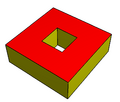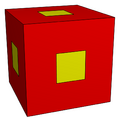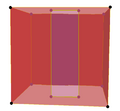Polygon with holes
 From HandWiki - Reading time: 3 min
From HandWiki - Reading time: 3 min
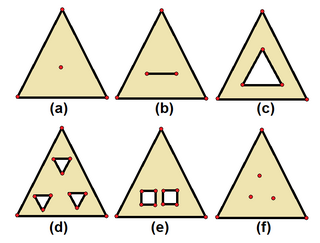 Polygons with holes, with simply connected brown regions and interior boundaries, including degenerate cases of single vertices and edges, (a,b,f). | |
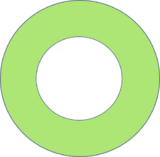 Circular |
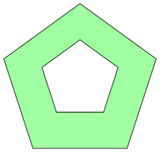 Pentagonal |
| An annulus can be approximated by two n-sided boundaries with the same center, but different radius. | |
In geometry, a polygon with holes is an area-connected planar polygon with one external boundary and one or more interior boundaries (holes).[1] Polygons with holes can be dissected into multiple polygons by adding new edges, so they are not frequently needed.
An ordinary polygon can be called simply-connected, while a polygon-with-holes is multiply-connected. An H-holed-polygon is H-connected.[2]
Degenerate holes
Degenerate cases may be considered, but a well-formed holed-polygon must have no contact between exterior and interior boundaries, or between interior boundaries. Nondegenerate holes should have 3 or more sides, excluding internal point boundaries (monogons) and single edge boundaries (digons).
Boundary orientation
Area fill algorithms in computational lists the external boundary vertices can be listed in counter-clockwise order, and interior boundaries clockwise. This allows the interior area to be defined as left of each edge.[3]
Conversion to ordinary polygon
A polygons with holes can be transformed into an ordinary unicursal boundary path by adding (degenerate) connecting double-edges between boundaries, or by dissecting or triangulating it into 2 or more simple polygons.
In polyhedra
Polygons with holes can be seen as faces in polyhedra, like a cube with a smaller cube externally placed on one of its square faces (augmented), with their common surfaces removed. A toroidal polyhedron can also be defined connecting a holed-face to a holed-faced on the opposite side (excavated). The 1-skeleton (vertices and edges) of a polyhedron with holed-faces is not a connected graph. Each set of connected edges will make a separate polyhedron if their edge-connected holes are replaced with faces.
The Euler characteristic of hole-faced polyhedron is χ = V - E + F = 2(1-g) + H, genus g, for V vertices, E edges, F faces, and H holes in the faces.
- Examples
- Examples with degenerate holes
A face with a point hole is considered a monogonal hole, adding one vertex, and one edge, and can attached to a degenerate monogonal hosohedron hole, like a cylinder hole with zero radius. A face with a degenerate digon hole adds 2 vertices and 2 coinciding edges, where the two edges attach to two coplanar faces, as a dihedron hole.
(genus 1) with two (degenerate point or monogon) 1-holed-faces.
V=10, E=15, F=7, H=2.
2-connected(genus 1) with two (degenerate digon) 1-holed-faces.
V=12, E=18, F=8, H=2.
2-connected
References
- ↑ The Geometry of n Dimensions, D. M. Y. Summerville, p.144 Ring-shaped polygons
- ↑ http://www.science.smith.edu/~jorourke/books/ArtGalleryTheorems/Art_Gallery_Chapter_5.pdf[bare URL PDF]
- ↑ [1] Jorge Urrutia, in Handbook of Computational Geometry, 2000
 |
 KSF
KSF

